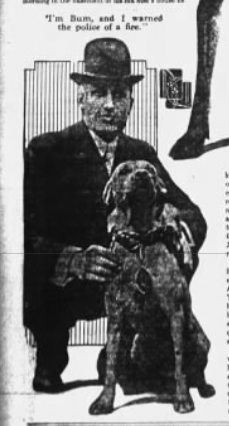
When Patrolman Cornelius O’Neil found the yellow dog he named Bum on Mulberry Street in Little Italy, the mangy mutt was half-starved and trailing remnants of a pack of firecrackers by his tail. Patrolman O’Neil decided to rescue the dog and make him the mascot police dog of the newly designated 12th Precinct of the New York City Police Department.
Little did he know it on that day in July 1908, but over the next eight years, Bum would earn his weight in gold many times.
During the early 1900s, the Little Italy neighborhood was a breeding ground for gangster violence. In the heart of this neighborhood was the notorious Mulberry Street of Five Points (Gangs of New York) fame. This avenue of pool halls, saloons, and back-alley gambling spots was also home to some of the most famous and influential Italian American gangsters in history.
It was on Mulberry Street that the first Italian immigrants made their homes in America in the late 1800s and early 1900s. These poor people lived in crowded, filthy, rat-infested Old Law dumbbell tenement buildings that were literally airless firetraps.
Lucky for some of them, Bum was attracted to fire more than the firemen of what was then Engine 13 at 253 Lafayette Street and Ladder 9 at 209 Elizabeth Street.
He loved nothing more than responding to the big fires with his “pack” and often assisted the police and firefighters in making rescues by leading them through smoke to window-less rooms where frightened children and their mothers were huddled together.
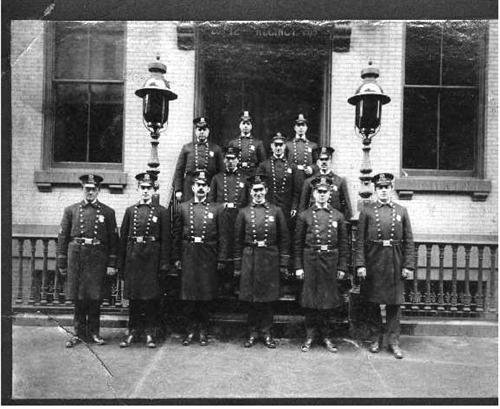

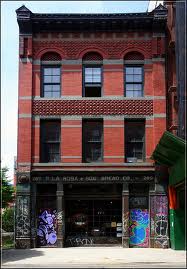
One day in the spring of 1912, Bum was on patrol with his human partner when he saw a cat run into an open door of a tenement building on Mulberry Street. Being a dog, Bum was naturally inclined to break free from his partner and chase the cat into the building. I like to think that the cat was also a hero in this story, because she led Bum into a tenement that was on fire.
Bum emerged from the tenement, grabbed O’Neil by his coat, and dragged him into the hallway. O’Neil followed obediently and found smoke coming from the basement.
As the partners ran up stairs and down hallways, Bum barked furiously the whole time to alert people of the danger so they could safely evacuate the building.
Bum Receives a Medal
Bum’s heroic deed on Mulberry Street came to the attention of Mrs. Knox Bull of the Bide-a-Wee Home, a nonprofit humane group that rescued and provided care for stray and unwanted cats and dogs.
The organization presented Bum with a bronze medal in July 1912 that was inscribed “Bum, Twelfth Precinct” on one side, and featured a female figure and a dog on the other.
Bum would rescue many people and receive other awards during his tour with the 12th Precinct.

On Memorial Day in 1914, Bum received a lifesaving award at Manhattan’s eighth annual Workhorse Parade, sponsored by the New York Women’s League for Animals. At this event, he was honored for helped save the life of a child whose clothes had caught fire during a bonfire.
A Brief History of Bide-A-Wee
Bide-a-Wee, which means “stay awhile” in Scottish, is one of the oldest humane organizations in the United States (today it’s spelled Bideawee). The organization was founded in 1903 by Mrs. Flora D’Auby Jenkins Kibbe of New York City, who based her organization on the Barrone d’Herpents Dog Refuge in Paris.
This humane group sent an ambulance all over Paris to pick up stray and unwanted dogs. Instead of being destroyed, they were cared for until they could be placed in new homes.
Mrs. Kibbe called her new organization the Bide-A-Wee Home Association, which operated out of a small building near her home in Manhattan. With the help of friends, Bide-A-Wee was officially incorporated as a not-for-profit in 1906.
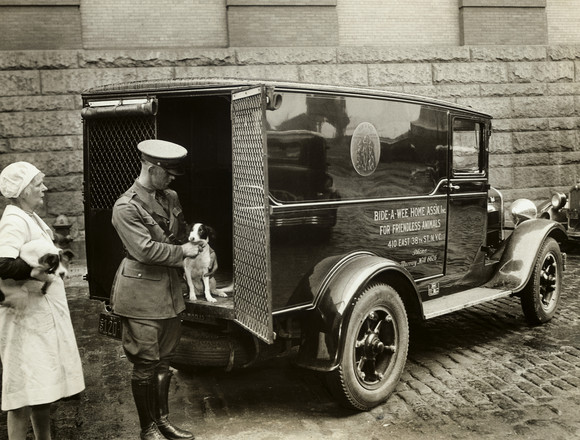
Its main mission was to alleviate the sufferings of homeless and abandoned animals, and to spread the gospel of humanity toward dumb creatures by practical example. In addition to helping strays, during its early years the group also placed and maintained troughs filled with fresh drinking water for carriage horses on the streets.
By 1909, the building near Mrs. Kibbe’s home housed 200 dogs. The neighbors weren’t too keen about the constant barking, so Mrs. Kibbe was forced to find a new home for the animals. For the next several years, as she looked for a permanent new home, the animals were kept in a series of temporary shelters.
The organization finally moved to 410 East 38th Street, which is the current headquarters. They also began operating a country home and pet cemetery in Wantagh, Long Island.
Since that time, Bideawee has expanded to include two pet memorial parks in Wantagh and Westhampton, where thousands of pets from the New York metropolitan area have been buried over the years.
Murder and Mayhem on Mulberry Street
In May 1913, just a year after Bum received his medal for saving lives at the tenement fire, the 12th Precinct found itself in the middle of a national manhunt for a notorious gangster and cop killer. This is one of those stories you just can’t make up.
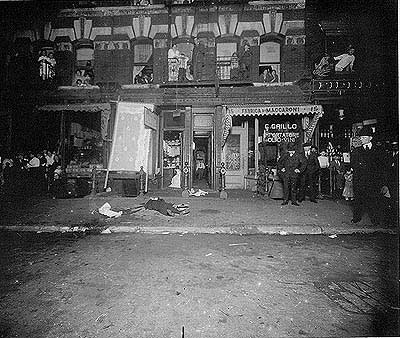
On the night of May 3, Patrolman William B. Heaney, a rookie with only two months on the job, was at his post on Mulberry Street between Spring and Bleecker. He had just 30 minutes to go before his shift ended at midnight.
At about 11:30 p.m., a shot rang out in the street nearby. Patrolman Heaney ran toward 235 Mulberry Street, a new (1910) five-story apartment building with a combination pool hall and café on the ground floor. As he approached, he saw two men dragging what appeared to be a dead man into the building. The dead man was a 33-year-old bookkeeper named John “Kid Morgan” Rizzo of 41 Spring Street. The men dragging him were James Morelli and 21-year-old Oresto Shillitani, aka “Harry Shields” and “The Paper Box Kid.”

“You’re under arrest!” Heaney shouted while running toward the men from across the street. He pulled out his nightstick and struck Shillitani on his head above the ear. Shillitani responded by shooting Heaney three times: once in the mouth, once in the right lung, and once in the hand. Heaney died instantly. The 25-year-old rookie and newlywed dropped onto the sidewalk and rolled into the gutter in front of 241 Mulberry Street.
Patrolman Charles J. Teare, who was on the 10 p.m. to 6 a.m. tour, heard the shots from his post, which was just one half block away. He ran south down Mulberry Street and fired his revolver twice. Unfortunately, both shots missed Shillitani. The Paper Box Kid fired back, hitting Patrolman Teare twice in the neck.
All hell broke loose at the Mulberry Street station, which was just a block away. Officers rushed to the scene to care for their fallen brothers, cordon off the crowds, and question onlookers.
Back at the station, someone called Saint Vincent’s Hospital to summon an ambulance. While all this commotion was going on, Patrolman Teare used some of his last breaths to tell the other officers what had just transpired.
The first ambulance surgeon on the scene was Robert John McGuire. All three men were admitted to St. Vincent’s Hospital, although Patrolman Heaney was pronounced dead on arrival. The Rev. Dr. Gill of St. Patrick’s Church performed last rites for Rizzo and Teare. Patrolman Teare (badge #10009), a twelve-year veteran with the NYCPD, died the next day from his wounds. The 36-year-old officer was survived by his mother, who had lived with him at 683 Greenwich Street.

Nationwide Manhunt
The triple murder set off a nationwide manhunt. The New York Tribune and Middletown Daily Times-Press printed a description of the murderer as follows:
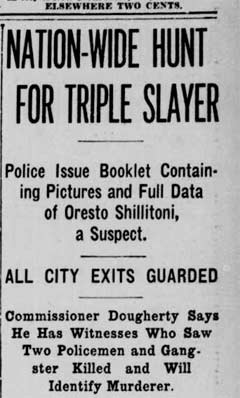
Italian-American, Age Twenty-One years, 5′ 1 3/4″, weight 125 pounds, slender build, thick black hair cut high up on the back of the neck, blue eyes, dark yellow sallow complexion, skin quite rough, smooth-shaven, slightly pockmarked. Associates with prizefighters and is a frequenter of cheap grade pool and billiard rooms. He was last seen wearing a grey striped suit, black derby hat, coat cut square, black shoes with bulldog toe, and a diamond horseshoe tie pin.
The manhunt finally ended when Oresto’s brother, Johnny, made arrangements for him to surrender to police on June 13. The court convicted him of murder in the first degree and sentenced him to death following solitary confinement in the Death House at Sing Sing Prison in Ossining, New York.
One June 21, 1916, only eight days before his execution date, someone – possibly a sister-in-law — smuggled a gun into him during a visit. Early the next morning, Shillitani asked Guard Daniel McCarthy to bring a slop bucket to his cell so he could relieve himself. When McCarthy opened the cell door, he shot the guard to death, grabbed his keys, and escaped from the prison.
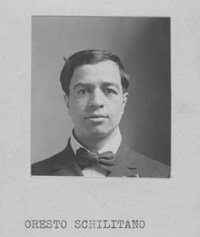
As the prison’s siren, “Big Ben,” began to blast, Shillitani was able to scale the twelve-foot fence and make it to the rocky shores of the Hudson River. Following a cold and disorienting swim, he emerged at the south end of the prison, took off his wet clothes, and walked toward the only building with a light – the Ossining Hospital.
There, he startled the night attendant, Ms. Elaine, by brandishing a revolver and asking her for some clothes and a room for the night. Luckily the attendant kept her wits and was able to stall him while waiting for armed guards from the prison and local police to arrive.
Shillitani was returned to Sing Sing, where he was kept sedated until the day of his execution. He died by electric chair at 6:01 a.m. on June 30, 1916.
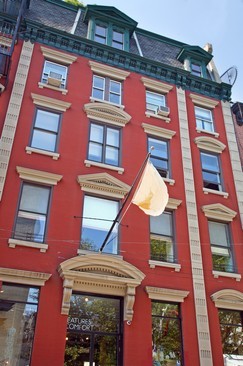
On December 1, 1916, just five months after Shillitani’s execution, the 12th Precinct was abolished and the station house closed. After the precinct was abolished the police department used the building as a storehouse. Around 1923 it was taken over by the NYPD Building and Maintenance Section and used as workshops and the storage of building supplies. Today the building–pictured above–is home to expensive co-op apartments and the Creatures of Comfort clothing boutique.
For a much more detailed account of this fascinating true crime story, read John Scillitani’s “Gangster Original.”


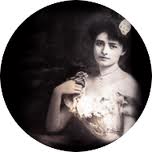

[…] Access to the yard was via a three-foot-wide passageway between the front houses at 301 and 303 Mulberry Street, which were owned by New York City Comptroller Richard Alsop Storrs. Directly across the street from Cat Alley was the New York Police headquarters at 300 Mulberry Street. […]
[…] Access to the yard was via a three-foot-wide passageway between the front houses at 301 and 303 Mulberry Street, which were owned by New York City Comptroller Richard Alsop Storrs. Directly across the street from Cat Alley was the New York Police headquarters at 300 Mulberry Street. […]